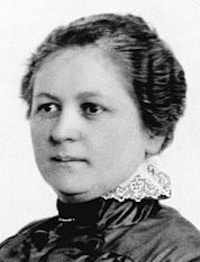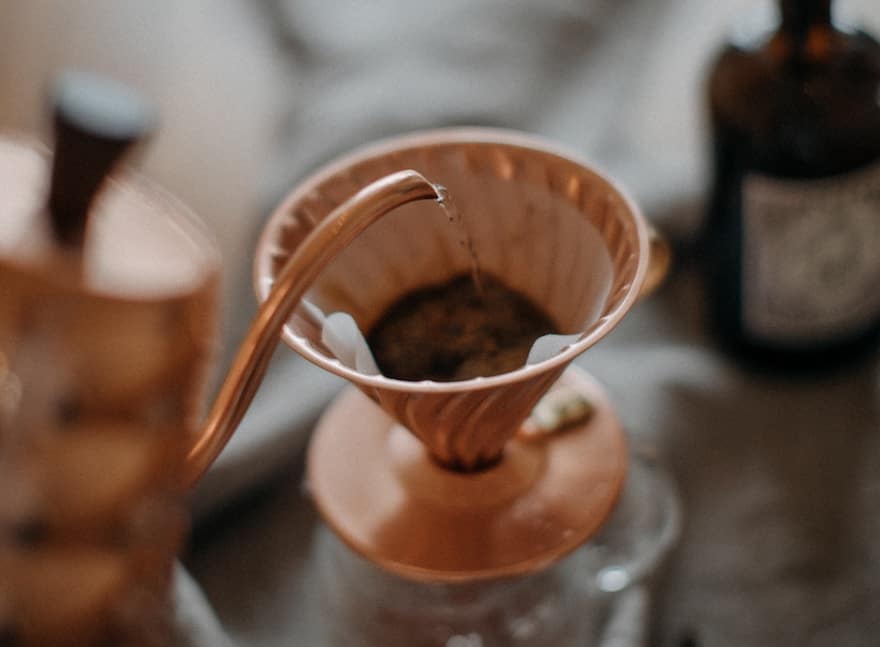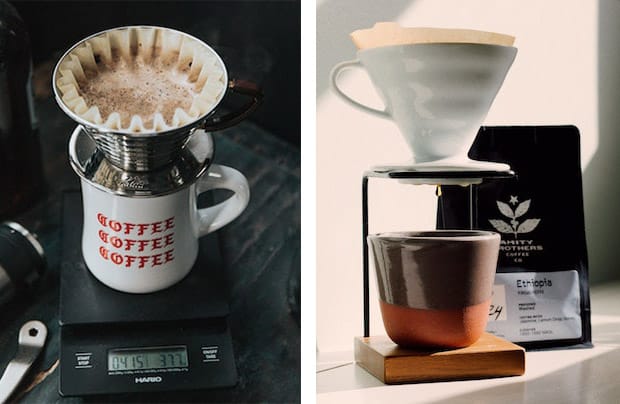Just so you know, as an Amazon Associate we earn from qualifying purchases made via bold red links, buttons or images.
Last Updated on December 13, 2023
When it comes to coffee, there’s no better home brew than the one you can get with a pour-over technique. Any home barista worth their beans knows you need to use the right equipment to get the most out of your cup of coffee.
If you’re venturing into pour-over coffee, then you also need a pour-over brewer. It’s hard to find a better brewer than the Kalita Wave or Hario V60. Which begs the question: Which of the devices is better? When it comes to choosing between these coffee drippers, it comes down to one thing and one thing only: How do you like your coffee?
Kalita Wave
Hario V60
Pour-over coffee origins
Her name was Amalie Auguste Melitta Bentz. If you recognize the Melitta name, then you know that it’s the brand name of a well-known company that sells coffee filters for machines all over the world. Back in the early 1900s, Melitta Bentz began to look for a better way to brew coffee due to the coffee grounds that were always left behind. She patented the pour-over method after coming up with it through piercing blotting paper and utilizing a can.

Coffee making can, of course, be traced back hundreds of years. Even throughout Melitta Bentz’s time, Latin America was already making coffee by straining beans through a cloth. Yet once Bentz and her husband were able to create the paper filter, everything changed for the coffee-making world. Now, Melitta is its own flourishing coffee brand with coffee products still on the market today.
As with anything ever invented, sometimes another company or country can make it just a little bit better. The Japanese brands behind the Kalita Wave and Hario V60 have further revolutionized pour-over brewing techniques with their own products. The baristas of the world will be forever thankful.
Product overview
Kalita Wave
This flat-bottom coffee brewer is made with stainless steel and provides a simple and consistent brew. This Japanese brand intended the Kalita Wave to be an all-around, easy-to-use pour-over brewer that can deliver easy and quick results. With that mission in mind, this pour-over brewer is successful. While it is a simple coffee brewer, it brews coffee similar in quality to that made from coffee machines.
Keep in mind that the flat-bottom shape has its rewards and drawbacks. The reward is consistency, but the drawback is that you won’t always get the most out of your brew. The Kalita Wave is great for beginners who want to get into coffee, but may leave something to be desired for more experienced baristas.
Pros:
- Stainless steel material is easy to clean.
- Flat bottom allows for consistent brews.
- Great pour-over brewer for first-time users.
Cons:
- The 1-2 cup sizes are much smaller than advertised.
- Requires Kalita brand filters, limiting your filter options.
Hario V60
The Hario V60 is a great pour-over brewer in a cone shape, available in a variety of materials. This is also a Japanese brewer and was created with one thing in mind: to help users get the most flavor and experience out of their coffee. The alternate materials include plastic, glass and copper, but ceramic is the most popular version. The Hario also comes in two different sizes.
This pour-over brewing device is best for either experienced baristas or those who are willing to dedicate some time and effort to their coffee brewing process and learn how to get the most out of their coffee beans. While still simple in design, this version has added subtleties such as the spiral ripples and a large single hole at the bottom that can affect the extraction and taste of your coffee.
Pros:
- Cone shape helps bring out optimal taste and flavor from your ground coffee.
- Dishwasher safe and easy to clean.
- Less expensive than other competing pour-over brewing brands.
Cons:
- Requires thoughtful practice and know-how to get good extraction.
- Filters will have to be sought after online, or in Japanese stores.
Difference between Kalita Wave and Hario V60
Shapes and sizes
There are a few different shapes that exist in the pour-over brewing world, but the most relevant to the Kalita and the Hario are the flat-bottom and cone shapes.
Let’s start with the Hario. The V60 has a conical shape with a 60-degree angle. This shape funnels the ground coffee and water from your kettle to a concentrated area, which makes the timing and evenness of your pour quite important for getting the ideal extraction. If you just dump your water in and forget about it, the grounds in the bottom of the funnel will likely be over-extracted and produce bitter coffee.
The V60’s wide opening means you rely on the size of your coffee grounds to slow the water down as it passes through.
The Kalita Wave on the other hand takes advantage of its flat-bottom shape to ensure consistency of pour-over brewing. Unlike the Hario, the Kalita’s flat bottom has three holes that allow for slower water flow. This clever dripper shape means that water from your kettle will gather evenly in the bottom of the dripper and you should be able to get the same tasting cup of coffee every time.
The Kalita comes in only two sizes. The smaller size is good for a single cup and the larger size will brew for two.
The Hario comes in three sizes: two cups, four cups and six cups.
Material
You can get your pour-over brewer in a few different materials. Each has its strengths and weaknesses. Ultimately, the choice will come down to what you want to get out of your coffee brewing experience. Below is a list of the materials for both the Kalita Wave and the Hario V60.
- Stainless steel/metal
- Plastic
- Ceramic
- Glass
Any of these will get the job done, each with its own drawbacks. For example, the cheapest material you can get is plastic, but a cheap price usually also means lower quality that may affect the flavors from coffee.
There is also glass, which is the most fragile of all the materials, but the most elegant. Metal and ceramic are great choices that lie somewhere in the middle in terms of quality and price. The only thing you’ll have to do is be sure to warm up the ceramic or glass drippers beforehand with some hot water from your kettle, to facilitate better interaction between coffee grounds and the coffee basket. You don’t want to begin pouring with the grinds in a cold brewer, as the coffee oils may not fully extract.
Brewing consistency
When it comes to making your pour-over, you’ll either want something quick and consistent or something meticulous but flavorful. With the Kalita Wave, you can be assured to get the same cup of strong body coffee every morning. With the Hario V60, by perfecting your method you can achieve the most flavorful cup of coffee possible.
Your decision will ultimately rest on which type of brewing is more important to you, and which outcome you prefer. Sometimes you want something quick and easy, and you won’t have time to go through the pour-over process. It can also depend on how you want your coffee to taste. Some prefer a bolder taste that isn’t too subtle (Kalita), while others prefer more nuance in their coffee (Hario).

The Hario V60 is shaped specifically to encourage a detailed pour-over brewing process that requires some practice to perfect. You don’t want to drown your grind, but you also don’t want to underwater them. The way you approach your method will also depend on the amount of coffee you’re making. You won’t necessarily water it the same way for four cups of coffee as you would for two cups of coffee. Brewing with the Hario V60 is a meticulous method that demands some time and trial with batches, but once you perfect the technique the coffee produced can outdo even the best coffee machines.
Which coffee dripper should you choose?
The difference between these two coffee brewers lies in the flavor, and ease of the brewing itself. With the Kalita, you have comfort and ease taking precedence over flavor whereas the Hario is the other way around. The Hario requires attention to time, temperature and pouring style and can yield spectacular flavor, while the Kalita focuses on simplicity—perhaps at the expense of some flavor.
When it comes down to it, your decision between the Kalita Wave and the Hario V60 will depend on your preference for drip filter coffee. We prefer a pour-over that will help us get the most out of our coffee taste and experience, which means we go with the Hario V60.
Here’s how you can decide whether the Kalita Wave or Hario V60 is for you and your tastes:
Choose the Kalita Wave if you:
- Want a brewer that’s simple and easy to use.
- Care about your coffee and expediency too.
- Consistency is essential to starting your day right.
Choose the Hario V60 if you:
- Enjoy the pour-over process and can make it a part of your morning schedule.
- Care more about the flavor outcome of your coffee than anything.
- Don’t mind practicing and embracing the pour-over method and testing batches.


